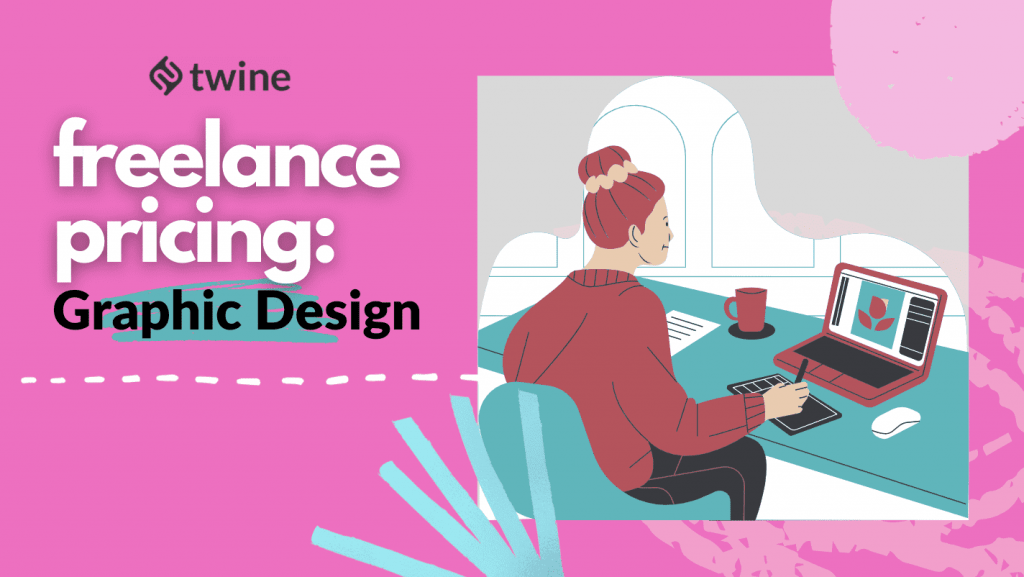
When you’re just setting out in the world of freelance design, knowing what to charge can be difficult. There are no hard and fast rules and everyone does freelance pricing differently.
Then there’s the complicated matter of how to charge. Do you use an hourly rate or charge a per-project fee? And what about price lists?
We’ll take a look at how to charge without undervaluing your worth, and what method to apply when.

For most first-time freelancers, the concept of charging money for their design work is an awkward and slightly alien one. Talking about money can often be uncomfortable. But in the fast-paced world of freelance pricing, you need to develop some business skills and quick otherwise you will get left behind.
Determining your rates can be a hard thing to get right. There’s a fine line between underselling yourself and ripping someone off.
What you charge should be right for your experience level (don’t demand senior-level fees if you’re a junior), but also be competitively priced in order to draw in customers. Oh and make sure you’re earning enough to cover yourself each month (including pension, social security, health care, tax, etc).
It’s a nightmare!
Should I use a price list?

A novice freelancer’s first foray into pricing up their services might include drawing up a freelance pricing list.
Price lists are what they say they are on the tin – a one size fits all list of services and the price. If someone asks for a logo, you charge the price on your list, no matter what the project is. Don’t get me wrong, some designers use price lists very effectively, but they can definitely hold you back from reaching your potential.
The thing is, different clients have different budgets, and no two projects are ever the same. In this game, it pays to remain flexible. If a mega-rich business owner comes to you with a large branding project, it’s in your best interests to be able to increase your fees. Mr. Moneybags wants tons of revisions and the project overruns.
If you quote your usual freelance pricing list for a branding project, you’ll have massively undersold yourself.
You end the project feeling dead inside and possibly unable to pay the bills that month. But for what? This client has the budget to pay a bit more, and this project was loads of hassle. So don’t feel bad about increasing your price.
Equally, there will be times when a client can’t afford your fees, but you want to work on their project so badly that you agree to reduce your rates. So, lesson 1 – stay flexible.
Should you charge hourly or per project?

Two other standard freelance pricing list models are charging by the hour or charging per project. It’s never a good idea to put all your eggs in one basket – both these methods have their uses but don’t just stick to one for every project you do.
You can also try checking out Bonsai’s freelance rate calculator, which takes on board multiple freelance caveats such as role, skill, experience, and location!
Hourly:
Over a long period of time, charging by the hour will usually give you better value for money. So use this method when you have a large or ongoing project. If you can, make sure your client knows upfront roughly how many hours you’ll need to put into the project, so that they don’t get a massive shock when they receive the invoice.
For freelancing newbies, charging per hour is probably the easiest freelance pricing method to get your head around. The trouble with charging per project is that you need to be able to estimate how long it’ll take you to complete a project, then times by your hourly rate. This can be difficult if you’re not actually sure how long things will take you to complete yet.
Per project:
When you’re working on small to medium short-term projects, charging per project is by far the best method to use. If you stick to charging per hour, here’s what will happen:
As you get more experienced you’ll be able to do things faster. You’ll find it takes you less and less time to complete a project. So, a project which you were once able to charge 10 hours for, now only takes you 6. You’re still producing the same end product, but in effect, you’re now charging less. The quicker you work, the less you will earn when you charge by the hour.
When you charge by the hour, you should take your hourly base rate into consideration, but don’t use it as the only defining factor.
Other factors:

Depending on the requirements of the project, there are other aspects to consider that should affect what you charge.
How much will you enjoy this project?
If you’re asked to do a project which is going to give you a major headache, it’s tempting to turn it away.
It’s a familiar situation. The client is a nightmare, they’re controlling, demanding, won’t listen to your professional advice and by the end, you’ll want to scratch your eyes out.
The resulting piece of work is a pile of crap that you’re ashamed to let see the light of day, let alone display in your portfolio. But, the client is happy so that’s all that matters.
This piece of work isn’t going to propel your career forward, so it’s tempting to pass it by. But, as a freelancer who’s just getting established, you shouldn’t turn down the offer of money.
Instead, increase your rates to adjust for all the drama. In the end, quietly consign the project to Room 101 and never speak of it again.
See also boring clients and unethical projects. Everyone thinks they have a red line that they won’t cross. Or will they?
Licensing and rights management:
You’ll find a lot of clients will ask for various licenses and usage rights when you hand over your work.
You should adjust your fee depending on the level of control they want. If the client wants full ownership rights to the project, they should expect to pay between 1.5 x 2 more on top of the original project price.
This is to compensate for potential earnings lost once it’s no longer your property.
How do you calculate your rate?

First, start by working out how much money you need to get by every month.
We’re talking about bills, rent, food, transport, insurance, just the essentials. You can include a bit extra in order to maintain the lifestyle you enjoy, but don’t go crazy. Don’t factor in your daily Starbucks and new sneakers habit here – believe it or not, they are surplus to requirements.
So, now you’ve got a figure which is what it actually costs for you to live each month. You need to make at least this each month, or you’ll go under. You should use this to calculate base rates for your freelance pricing list, any hourly rates, or project fees that you quote.
Now, depending on the project, factor in any extenuating circumstances such as nightmare client, dream project, huge ongoing project, etc.
Don’t undersell yourself:

It’s so important for freelance designers to charge their actual worth.
By underpricing your work you’re not only harming yourself, it has a knock-on effect for the rest of the industry too. It’s so tempting when you’re just starting out to quote knock-down prices in order to secure business. But, stick to your guns and remember that your talent has value.
Companies know this, but if you give them the chance to underpay, they will. Quoting less for jobs simply drives down prices for everyone else too. And nobody wants that.
Update 19/10/2016: Jake Jorgovan shared his thoughts on the matter in this blog post for Career Foundry and it’s well worth a read!
Ready to get hired? At Twine, we have dozens of top-quality jobs being posted each and every day. From design to marketing, development to copywriting – there’s a job ready for your skills. Join the marketplace of creative talent here.



